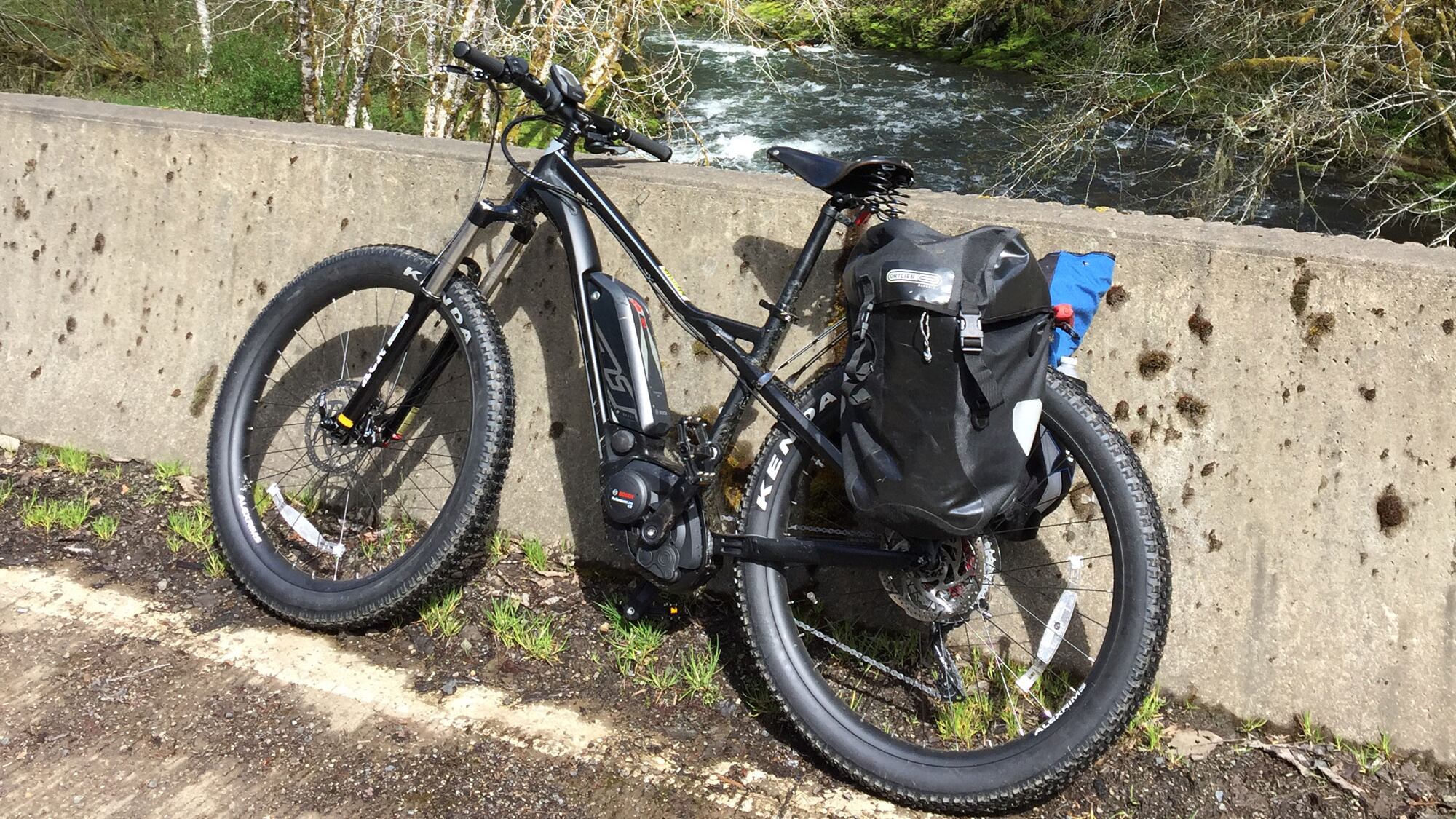The word "lookout" should've been a giveaway.
Lookouts tend to be up—the opposite of my preferred direction for the last bit of my 55-mile trip from Carlton, in Willamette Valley wine country, to the Oregon Coast.
But here I am, huffing up the hill to Cape Lookout, where I told my ride to meet me, instead of rolling down to Sand Lake, where dirt bikers rev around.
The battery meter says I've got 1 mile of power on the lowest setting.
When I say battery meter, I'm not being metaphorical.

I'm riding an electric bike with fat, knobby tires nearly twice the size of standard mountain bike tires. On this bike, made by Izip and borrowed from Cynergy E-Bikes on Southeast Powell Boulevard, the battery gives you a little extra push as you pedal. That push basically makes it feasible to attempt this ride on this bike, weighed down with supplies and fat tires. With the pedal assist on its lowest setting, which is the only way to complete a ride like this, the beastly bike is just a bit easier to pedal than my everyday ride, a commuter bike with an internal hub gear.
Everything about this is simultaneously stupid and brilliant—if I don't say so myself.
I've dreamed of biking this route, the Nestucca River Road, since the last time I rode to the coast, five years ago, along busy Oregon Route 6.
That ride was miserable. I was a daily bike commuter then instead of a day care dad, and in much better shape. Still, the mountains of the Coast Range are punishing, especially on a heavy commuter bike with a flat handlebar. Mostly, though, it was the cars—the lifted trucks flying around turns at twice the speed limit, tossing empty cans of Busch out the window onto a forest floor covered in black malt liquor cans and frosted Boone's Farm bottles.
A few miles from Tillamook, a guy in a car pulled over in front of me and offered an orange vest. "Please wear this," he pleaded. "You really have to be visible out here."
I put on the vest—I was shell-shocked from cars roaring by, sometimes just a few feet from me on tight curves—and when I got back from that trip, I went straight to River City Bicycles in Southeast Portland and bought the brightest gear on the shelves.
"I rode out to the coast last weekend, and now I'm scared of cars," I told the clerk.
"Bruh," he said, "next time you gotta take Nestucca."
Nestucca, as I quickly found out, is one of Oregon's best-loved bike routes. It starts as Meadow Lake Road in Carlton, and winds through the mountains to the town of Blaine. It's the most direct route from the valley to Tillamook, but it's a steep and rugged road, part of which is potholed gravel, which keeps speedy traffic to a minimum. Ever since I heard about it, I've been a little obsessed, even driving the road to scout.
But, I've also been torn.
The most fun thing about riding a logging road is bombing the hills and spraying gravel, but doing a six-hour marathon with 2,500 feet of vertical gain on a mountain bike seems miserable.
Enter the electric fat bike.
This super-cool contraption is probably the most fun bike I've ever ridden.
But even though electric bikes have come a long way, the 400-watt batteries are only good for 40 miles of minimal help on hilly terrain, or 10 miles with more help. They're not meant for an epic, long-distance climb like Nestucca River Road. A friend who's had an e-bike for close to a decade told me I was crazy. Almost every shop in town, and two manufacturers, blew off my requests to chat about the feasibility of making the trip.
The only person who got back to me was Rich Fein of Cynergy. We are both from Northeast Ohio, so we're a bit more intense than your typical Oregonian. Moreover, Fein is one of those people curious to see how far we can push e-bikes.
He became enchanted with the idea of e-bikes in the late '90s, when they were championed by former Chrysler CEO Lee Iacocca. After retiring, Fein moved to Portland specifically to open his shop. His research indicated Portland was an ideal place for e-bikes because of its weather, moderate hills, wealth and bike infrastructure.

"He wants to save the world, and he thinks his bikes can do it," his wife, Ruthellen, told me on my test ride.
E-bikes may or may not be able to save the world, but can they conquer a rugged logging road in the Oregon Coast Range?
My goal was to find out—hopefully without having to pedal a lumbering 75-pound packhorse up any steep grades and beating the 6-hour, 15-minute time Google Maps said the trip would take with a normal bike.
I set out from downtown Carlton at 8:15 am on a sunny Saturday morning, with two fully charged batteries, 3 liters of water and a box of granola bars.
The first 20 miles are a steady uphill climb, and I handled the hills easily with the help of the e-assist. Maybe too easily. I used the midlevel of assistance for a few steep stretches and made fantastic time, averaging about 13 mph. But I also wore through the first battery pretty fast. Only 16 miles in, my first battery conked out. I became far more conservative with my electricity after that, knowing that without any boost, this bike would be a true beast.
Finally, I arrived in the town of Beaver, having seen perhaps 50 cars in a 50-mile trip, most traveling at pleasantly slow speeds.
But in Beaver, I had to merge onto Highway 101, where all those can-tossing trucks would speed by. I had a quarter charge left and desperately wanted to top off my battery to avoid an outage, and maybe even get enough juice to hurry the hell off the highway.
I spotted a deli, and rode up to get some lunch and a charge. No luck—the deli is out of business and the outdoor outlets had no electricity.
So I rode over to a Shell station, where I could see a few outlets on the outside of the building.
The gentleman pumping gas didn't look especially friendly, but I wasn't in a position to pass without trying.
"Hey, sir, this is an electric bike and the battery is very low," I said. "I was wondering if I could plug it in for a few minutes? I'd be happy to pay. A full charge costs 50 cents, and I won't even use that."
I'd lied—in Portland, at least, a full charge costs only about 10 cents, according to Rich Fein's estimate.
"We don't do that," the attendant said, sternly. "And we don't have any outlets out here."
He lied—I could see the outlets.

"Well, I could plug the battery in inside and hang out here. I'll give you money."
"We don't do that. And all out power outlets inside are used."
My rage powered me a few more miles, where I came across a campground called Camper Cove. A very nice man mowing the lawn grabbed an extension cord out of the garage and told me to charge up as long as I wanted. I wandered around the pretty little family campground nestled up against the river.
I spent about an hour putting a little juice into the dead battery in my bag and then topping off the bike.
Then I called my ride, still in Portland, and told him to meet me at Cape Lookout in 90 minutes—which was a very stupid thing to do.
The mistake was evident just after I passed the turn-off to Sand Lake, where the road to Cape Lookout started a steady 750-foot, 5-mile climb to the trailhead. As the climbing continued, I realized I was looking down on the dunes where I should have been. The battery monitor started blinking. I pedaled even harder. The battery died. I got off the e-bike to walk.
Then I remembered the other battery in my bag that had a good 20 minutes of charge. Could I make it on that?
In fact, I could. Just as the battery started blinking again, I arrived at the lookout.
I had a beautiful view of Sand Lake—where any smart cyclist would have gone.

Welcome to the 2017 Bike Issue
Portland Made Driving Miserable. All You Can Do Now is Bike.
What It Would Take For Portland To Become a Globally Elite Bike City?
A Selection of the Best New Cycling Gear
BikeTown isn't Just For Tourists. I Used It For a Week and It Was Great.
BikeTown Is Killing Portland Bike Shops
I Took An Epic E-Bike Ride from the Willamette Valley to the Coast
Is Portland's Proud Bike Culture Stunting the Adoption of E-Bikes?

